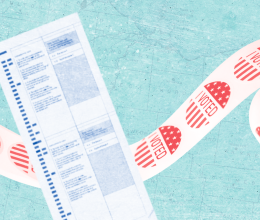Last week, Secretary of State Frank LaRose penned an op-ed in the Cincinnati Enquirer titled Ohio is a model for how to run elections. The piece gives high praise to Ohio for how smoothly our election went, citing how fast we released our results on election night, the state’s impressive poll worker recruitment, and the convenience of our absentee ballot system. If one were to read only the Secretary’s words, they would think Ohio’s election went off without a hitch.
We know that not to be true.
Instead, critical flaws were again exposed in Ohio’s antiquated election system. People waited for hours in long lines during the early voting period, vendors were overwhelmed with absentee ballot mailings, and a disorganized voter registration system forced tens of thousands of Ohioans to cast provisional ballots.
Fortunately, the problems we experienced during the 2020 General Election can be fixed. The Ohio General Assembly has ample time before our next major elections in 2022 to modernize our system and harness twenty-first century technology and other advancements.
We urge our lawmakers to consider all of the following measures during the next legislative session starting in January 2021.
- Update Ohio’s Voter Registration System – According to the National Conference of State Legislatures, Ohio has the strictest voter registration deadline allowed under federal law. Voters must register to a vote a minimum of thirty days before an election, well before a large portion of the population becomes interested in, or even aware of, the election. This deadline, coupled with our controversial “supplemental process” for voter roll maintenance (otherwise known as the voter purge) makes it unnecessarily burdensome for voters to register – and stay registered – to vote. This would change if the General Assembly passed legislation to make our voter registration system more accessible to all Ohioans.
Additionally, Same Day Registration (SDR) is the crown jewel of voter access. SDR allows voters to register to vote and cast a regular ballot on the same day. Currently, twenty-one states and the District of Columbia offer SDR. These are red states and blue states, rural and urban, big and small. The benefits speak for themselves: SDR increases voter turnout, eliminates arbitrary registration deadlines, helps maintain accurate voter lists, and acts as a failsafe for younger, poorer, and more transient populations that historically have been cut out of our democratic process. Election administrators in states with SDR attest that SDR does not compromise election integrity, as audits and redundancies are built into the system to prevent and identify voter fraud.
In 2005, the General Assembly passed a host of election reforms including what came to be known as “Golden Week.” Golden Week was the creation of overlapping time periods between Ohio’s registration deadline and the beginning of early voting, essentially giving voters a week long period where they can register or update their registration and then cast a ballot on the same day. Golden week was repealed in 2012, but advocates will continue to push for the return of the pro-voter policy in advance of 2022.
Along with Same Day Registration, Ohio lawmakers should also pursue the companion and complimentary electoral reform measure, Automatic Voter Registration (AVR). Secretary LaRose has already endorsed a version of AVR. Senate Bill 186 is a bipartisan bill that will streamline our voter registration system by allowing voters to electronically register or update their registration when interacting with state agencies like the Bureau of Motor Vehicles. Voters who don’t wish to register or update their registration can simply opt-out, much like shoppers do when declining to sign up for a retail store rewards program. It’s clear Ohio’s voter registration system is in need of improvement. The ACLU of Ohio strenuously suggests enacting both SDR and AVR so more Ohioans can have their voices heard, and we can remove arbitrary barriers to the ballot.
- Modernize Our Absentee Ballot System – Two of the major takeaways from Ohio’s 2020 election were: 1) Ohioans like absentee voting; and 2) our absentee ballot system is not suited for twenty first century voters. Pen and paper ballot requests, multi-step mailing procedures, postage requirements, and an over-reliance on an overburdened, under resourced postal service are just some of the weaknesses of Ohio’s absentee ballot system.
Again, there are a number of proposals that can fix these issues and make Ohio a national leader in the realm of absentee and early voting.
First is Senate Bill 191. Senate Bill 191 compels the Secretary of State to create an online absentee ballot request portal. This is common sense. In 2020, Ohioans can bank, process titles, and even complete the census all online. Why should requesting an absentee ballot be any different? Ohio’s Secretary of State agreed with this assessment when he said during supporting testimony that “[Senate Bill 191] will eliminate the wasteful initial step of requesting an absentee ballot application and will allow electors to directly request their ballot be sent to their home. This simple change to Ohio law will make absentee voting easier for all Ohioans.” The Ohio General Assembly still has time to pass this critically important bill this session, but if they don’t, voting advocates and our bipartisan board of elections officials will continue to pressure lawmakers to approve this commonsense proposal.
- Expand Access to Drop Boxes. The purpose of drop boxes is to give voters the option of depositing their completed absentee ballot in person without having to physically enter their county board of elections office, rather than return their ballot by way of the postal service. In September, Secretary LaRose issued an incredibly controversial order that limited the use of drop boxes to only one per county. Puzzlingly, Secretary LaRose, a vocal supporter of drop boxes in the past, resisted calls for expanded usage leading up to the election citing vague language and questions about his office’s authority in the Ohio Revised Code. State and federal lawsuits were filed to challenge this order, strike it down as unconstitutional, and ultimately allow for multiple drop box sites per county. The question at the center of both drop box lawsuits was whether counties were able to install multiple drop boxes at different locations. One would think, in a world still grappling with the COVID-19 pandemic, giving voters expanded access to in-person, socially distant, absentee voting would be a no brainer. That was not the case.
Rulings in both cases confirmed that there is no provision in state law prohibiting multiple drop boxes per county. Frustratingly, these rulings were appealed and appealed until it was too late to install additional drop boxes before the election, and Secretary LaRose has remained steadfast in denying his own office’s authority on the matter.
The General Assembly should do what’s right for Ohio voters and pass legislation explicitly granting counties the authority to install and operate multiple secure drop boxes in the future.
It is obvious that there is plenty of work to be done to modernize Ohio’s election system, and the policies listed here are by no means an exhaustive list. Our hope is the 134th Ohio General Assembly will be more supportive of protecting Ohioan’s right to vote and making our democracy as robust as possible.
The good news is that you can also do your part in ensuring that the fundamental right of voting is further accessible to everyone. Sign up for our Action Team here for alerts, updates, and calls to action. The ACLU of Ohio Action Team is our new Ohio-based activist community. This grassroots group is working to bring change to Ohio at the state and local level – and especially in the realm of voting rights.





